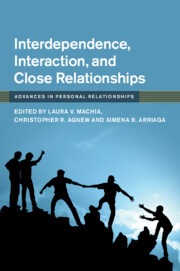Book contents
- Interdependence, Interaction, and Close Relationships
- Advances in Personal Relationships
- Interdependence, Interaction, and Close Relationships
- Copyright page
- Contents
- Figures
- Tables
- Contributors
- Acknowledgments
- Introduction
- Part I Interdependence, Situations, and Context
- Part II Interdependence, Security, and Risk
- 5 An Interdependence Analysis of Enhancing Attachment Security
- 6 Safe and Secure
- 7 Partner Buffering in Interdependent Relationships
- 8 Stress as a Risk Factor to Well-Being
- Part III Interdependence, Goal Pursuit, and Person Factors
- Part IV Interdependence, Timing, and Expectations
- Index
- References
7 - Partner Buffering in Interdependent Relationships
An Attachment Perspective
from Part II - Interdependence, Security, and Risk
Published online by Cambridge University Press: 19 June 2020
- Interdependence, Interaction, and Close Relationships
- Advances in Personal Relationships
- Interdependence, Interaction, and Close Relationships
- Copyright page
- Contents
- Figures
- Tables
- Contributors
- Acknowledgments
- Introduction
- Part I Interdependence, Situations, and Context
- Part II Interdependence, Security, and Risk
- 5 An Interdependence Analysis of Enhancing Attachment Security
- 6 Safe and Secure
- 7 Partner Buffering in Interdependent Relationships
- 8 Stress as a Risk Factor to Well-Being
- Part III Interdependence, Goal Pursuit, and Person Factors
- Part IV Interdependence, Timing, and Expectations
- Index
- References
Summary
Insecurely attached people have less happy, more unstable romantic relationships, but the quality of their relationships should depend on how their partners regulate them. Some partners find ways to buffer (emotionally and behaviorally regulate) insecurely attached individuals, which can make them feel better, behave more constructively, and improve their relationships. Understanding when, how, and why this important interpersonal process works requires a dyad-centered approach. In this chapter, we first review key tenets of attachment theory and the two primary forms of attachment insecurity (anxiety and avoidance). We then discuss the Dyadic Regulation of Attachment Insecurity Model, which outlines how and why certain types of buffering behaviors should soothe the worries and improve the relationship perceptions and behaviors of highly anxious and highly avoidant people. Following this, we discuss recent studies that illustrate some of the ways in which partners can successfully buffer the insecure reactions of highly anxious and highly avoidant individuals and how they can develop and maintain more “secure” environments. We conclude by suggesting future studies that might extend these recent findings and compare our model with some of the core concepts of Emotion-Focused Therapy.
Keywords
- Type
- Chapter
- Information
- Interdependence, Interaction, and Close Relationships , pp. 144 - 159Publisher: Cambridge University PressPrint publication year: 2020
References
- 1
- Cited by

